Energy conservation
| Part of a series on |
| Sustainable energy |
|---|
 |
Energy conservation is the effort to reduce wasteful
Green engineering practices improve the life cycle of the components of machines which convert energy from one form into another.
Energy can be conserved by reducing waste and losses, improving efficiency through technological upgrades, improving operations and maintenance,[1] changing users' behaviors through user profiling or user activities, monitoring appliances, shifting load to off-peak hours, and providing energy-saving recommendations. Observing appliance usage, establishing an energy usage profile, and revealing energy consumption patterns in circumstances where energy is used poorly, can pinpoint user habits and behaviors in energy consumption. Appliance energy profiling helps identify inefficient appliances with high energy consumption and energy load. Seasonal variations also greatly influence energy load, as more air-conditioning is used in warmer seasons and heating in colder seasons. Achieving a balance between energy load and user comfort is complex yet essential for energy preservation.[1] On a large scale, a few factors affect energy consumption trends, including political issues, technological developments, economic growth, and environmental concerns.[2]
User-oriented energy conservation
User behavior has a significant effect on energy conservation. It involves user activity detection, profiling, and appliance interaction behaviors. User profiling consists of the identification of energy usage patterns of the user and replacing required system settings with automated settings that can be initiated on request.[1] Within user profiling, personal characteristics are instrumental in affecting energy conservation behavior. These characteristics include household income, education, gender, age, and social norms.[3]
User behavior also relies on the impact of personality traits, social norms, and attitudes on energy conservation behavior. Beliefs and attitudes toward a convenient lifestyle, environmentally friendly transport, energy security, and residential location choices affect energy conservation behavior. As a result, energy conservation can be made possible by adopting pro-environmental behavior and energy-efficient systems.[3] Education on approaches to energy conservation can result in wise energy use. The choices made by the users yield energy usage patterns. Rigorous analysis of these usage patterns identifies waste energy patterns, and improving those patterns may reduce significant energy load.[1] Therefore, human behavior is critical to determining the implications of energy conservation measures and solving environmental problems.[3] Substantial energy conservation may be achieved if users' habit loops are modified.[1]
User habits
User habits significantly impact energy demand; thus, providing recommendations for improving user habits contributes to energy conservation. Micro-moments are essential in realizing energy consumption patterns and are identified using a variety of sensing units positioned in prominent areas across the home.[1] The micro-moment is an event that changes the state of the appliance from inactive to active and helps in building users' energy consumption profiles according to their activities. Energy conservation can be achieved through user habits by following energy-saving recommendations at micro-moments. Unnecessary energy usage can be decreased by selecting a suitable schedule for appliance operation. Creating an effective scheduling system requires an understanding of user habits regarding appliances.[1]
Off-peak scheduling
Many techniques for energy conservation comprise off-peak scheduling, which means operating an appliance in a low-price energy hour.[1] This schedule can be achieved after user habits regarding appliance use are understood. Most energy providers divide the energy tariff into high and low-price hours; therefore, scheduling an appliance to work an off-peak hour will significantly reduce electricity bills.[1]
User activity detection
User activity detection leads to the precise detection of appliances required for an activity. If an appliance is active but not required for a user's current activity, it wastes energy and can be turned off to conserve energy. The precise identification of user activities is necessary to achieve this method of energy conservation.[1]
Energy conservation opportunities by sector
Buildings
Existing buildings
Energy conservation measures have primarily focused on technological innovations to improve efficiencies and financial incentives with theoretical explanations obtained from the mentioned analytical traditions.[4] Existing buildings can improve energy efficiency by changing structural maintenance materials, adjusting the composition of air conditioning systems, selecting energy-saving equipment, and formulating subsidy policies.[5] These measures can improve users' thermal comfort and reduce buildings' environmental impact. The selection of combinatorial optimization schemes that contain measures to guide and restrict users' behavior in addition to carrying out demand-side management can dynamically adjust energy consumption. At the same time, economic means should enable users to change their behavior and achieve a low-carbon life. Combination optimization and pricing incentives reduce building energy consumption and carbon emissions and reduce users' costs.[5]
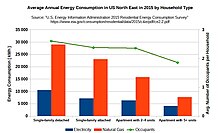
Energy monitoring through energy audits can achieve energy efficiency in existing buildings. An energy audit is an inspection and analysis of energy use and flows for energy conservation in a structure, process, or system intending to reduce energy input without negatively affecting output. Energy audits can determine specific opportunities for energy conservation and efficiency measures as well as determine cost-effective strategies.[2] Training professionals typically accomplish this and can be part of some national programs discussed above. The recent development of smartphone apps enables homeowners to complete relatively sophisticated energy audits themselves. For instance, smart thermostats can connect to standard HVAC systems to maintain energy-efficient indoor temperatures. In addition, data loggers can also be installed to monitor the interior temperature and humidity levels to provide a more precise understanding of the conditions. If the data gathered is compared with the users' perceptions of comfort, more fine-tuning of the interiors can be implemented (e.g., increasing the temperature where A.C. is used to prevent over-cooling). Building technologies and smart meters can allow commercial and residential energy users to visualize the impact their energy use can have in their workplaces or homes. Advanced real-time energy metering can help people save energy through their actions.
Another approach towards energy conservation is the implementation of E.C.M.s in commercial buildings, which often employ
Energy efficiency can also be achieved by upgrading certain aspects of existing buildings.[6] Firstly, making thermal improvements by adding insulation to crawl spaces and ensuring no leaks achieves an efficient building envelope, reducing the need for mechanical systems to heat and cool the space. High-performance insulation is also supported by adding double/triple-glazed windows to minimize thermal heat transmission. Minor upgrades in existing buildings include changing mixers to low flow greatly aids in water conservation, changing light bulbs to LED lights results in 70-90% less energy consumption than a standard incandescent or C.F.L. bulb, changing inefficient appliances with Energy Star-rated appliances will consume less energy, and finally adding vegetation in the landscape surrounding the building to function as a shading element.[6] A window windcatcher can reduce the total energy use of a building by 23.3%.[7]
Energy conservation through users' behaviors requires understanding household occupants' lifestyle, social, and behavioral factors in analyzing energy consumption.[4] This involves one-time investments in energy efficiency, such as purchasing new energy-efficient appliances or upgrading the building insulation without curtailing economic utility or the level of energy services, and energy curtailment behaviors which are theorized to be driven more by social-psychological factors and environmental concerns in comparison to the energy efficiency behaviors. Replacing existing appliances with newer and more efficient ones leads to energy efficiency as less energy is wasted throughout. Overall, energy efficiency behaviors are identified more with one-time, cost-incurring investments in efficient appliances and retrofits, while energy curtailment behaviors include repetitive, low-cost energy-saving efforts.[4]
To identify and optimize residential energy use, conventional and behavioral economics, technology adoption theory and attitude-based decision-making, social and environmental psychology, and sociology must be analyzed.[4] The techno-economic and psychological literature analysis focuses on the individual attitude, behavior, and choice/context/external conditions. In contrast, the sociological literature relies more on the energy consumption practices shaped by the social, cultural, and economic factors in a dynamic setting.[4]
New buildings
Many steps can be taken toward energy conservation and efficiency when designing new buildings. Firstly, the building can be designed to optimize building performance by having an efficient building envelope with high-performing insulation and window glazing systems, window facades strategically oriented to optimize daylighting, shading elements to mitigate unwanted glare, and passive energy systems for appliances. In passive solar building designs, windows, walls, and floors are made to collect, store, and distribute solar energy in the form of heat in the winter and reject solar heat in the summer.
The key to designing a passive solar building is to best take advantage of the local climate. Elements to be considered include window placement and glazing type, thermal insulation, thermal mass, and shading. Optimizing daylighting can decrease energy waste from incandescent bulbs, windows, and balconies, allow natural ventilation, reduce the need for heating and cooling, low flow mixers aid in water conservation, and upgrade to Energy star rated appliances consume less energy.[9] Designing a building according to LEED guidelines while incorporating smart home technology can help save a lot of energy and money in the long run.[9] Passive solar design techniques can be applied most easily to new buildings, but existing buildings can be retrofitted.
Mainly, energy conservation is achieved by modifying user habits or providing an energy-saving recommendation of curtailing an appliance or scheduling it to low-price energy tariff hours. Besides changing user habits and appliance control, identifying irrelevant appliances concerning user activities in smart homes saves energy. Smart home technology can advise users on energy-saving strategies according to their behavior, encouraging behavioral change that leads to energy conservation.[1] This guidance includes reminders to turn off lights, leakage sensors to prevent plumbing issues, running appliances on off-peak hours, and smart sensors that save energy. Such technology learns user-appliance activity patterns, gives a complete overview of various energy-consuming appliances, and can provide guidance to improve these patterns to contribute to energy conservation.[1] As a result, they can strategically schedule appliances by monitoring the energy consumption profiles of the appliances, schedule devices to the energy-efficient mode, or plan to work during off-peak hours.
Appliance-oriented approaches emphasize appliance profiling, curtailing, and scheduling to off-peak hours, as supervision of appliances is key to energy preservation.[1] It usually leads to appliance curtailment in which an appliance is either scheduled to work another time or is turned off. Appliance curtailment involves appliance recognition, activity-appliances model, unattended appliance detection, and energy conservation service. The appliance recognition module detects active appliances to identify the activities of smart home users. After identifying users' activities, the association between the functional appliances and user activities is established. The unattended appliance detection module looks for active appliances but is unrelated to user activity. These functional appliances waste energy and can be turned off by providing recommendations to the user.[1]
Based on the smart home recommendations, users can give weight to certain appliances that increase user comfort and satisfaction while conserving energy.[1] Energy consumption models of energy consumption of appliances and the level of comfort they create can balance priorities among smart home comfort levels and energy consumption. According to Kashimoto, Ogura, Yamamoto, Yasumoto, and Ito, the energy supply reduces based on the historical state of the appliance and increases according to the comfort level requirement of the user, leading to a targeted energy-saving ratio. Scenarios-based energy consumption can be employed as a strategy for energy conservation, with each scenario encompassing a specific set of rules for energy consumption.[1]
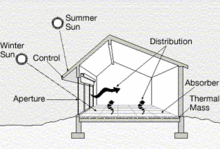
Transportation
Transporting people, goods, and services represented 29% of U.S. energy consumption in 2007. The transportation sector also accounted for about 33% of U.S. carbon dioxide emissions in 2006, with highway vehicles accounting for about 84% of that, making transportation an essential target for addressing global climate change (E.I.A., 2008).
In transportation, state and local efforts in energy conservation and efficiency measures tend to be more targeted and smaller in scale. However, with more robust fuel economy standards, new targets for the use of alternative transportation fuels, and new efforts in electric and hybrid electric vehicles, EPAct05 and EISA provide a new set of national policy signals and financial incentives to the private sector and state and local governments for the transportation sector.[10] Zoning reforms that allow greater urban density and designs for walking and bicycling can greatly reduce energy consumed for transportation. Many Americans work in jobs that allow for remote work instead of commuting daily, which is a significant opportunity to conserve energy.[citation needed] Intelligent transportation systems (ITS) provide a solution to traffic congestion and C.E.s caused by increased vehicles.[12] ITS combines improvements in information technology and systems, communications, sensors, controllers, and advanced mathematical methods with the traditional world of transportation infrastructure. It improves traffic safety and mobility, reduces environmental impact, promotes sustainable transportation, and increases productivity.[12] The ITS strengthens the connection and cooperation between people, vehicles, roads, and the environment while improving road capacity, reducing traffic accidents, and improving transportation efficiency and safety by alleviating traffic congestion and reducing pollution. It makes full use of traffic information as an application service, which can enhance the operational efficiency of existing traffic facilities.
The most significant energy-saving potential is that there are the most problems in urban transportation in various countries, such as management systems, policies and regulations, planning, technology, operation, and management mechanism. Improvements in one or several aspects will improve road transportation. Efficiency has a positive impact, which leads to the improvement of the urban traffic environment and efficiency.[12]
In addition to ITS, transit-oriented development (T.O.D.) significantly improves transportation in urban areas by emphasizing density, proximity to transit, diversity of uses, and streetscape design. Density is important for optimizing location and is a way to cut down on driving.[11] Planners can regulate development rights by exchanging them from ecologically sensitive areas to growth-friendly zones according to density transfer procedures. Distance is defined as the accessibility of rail and bus transits, which serve as deterrents for driving. For transit-oriented development to be feasible, transportation stops must be close to where people live. Diversity refers to mixed-use areas that offer essential services close to homes and offices and include residential spaces for different socioeconomic categories, commercial and retail. This creates a pedestrian shed where one area can meet people's everyday needs on foot. Lastly, the streetscapes design involves minimal parking and walkable areas that calm traffic.[11] Generous parking incentivizes people to use cars, whereas minimal and expensive parking deters commuters. At the same time, streetscapes can be designed to incorporate bicycling lanes and designated bicycle paths and trails. People may commute by bicycle to work without being concerned about their bicycles becoming wet because of covered bicycle storage. This encourages commuters to use bicycles rather than other modes of transportation and contributes to energy saving. People will be happy to walk a few blocks from a train stop if there are attractive, pedestrian-friendly outdoor spaces nearby with good lighting, park benches, outdoor tables at cafés, shade tree plantings, pedestrian courts that are blocked off to cars, and public internet connection. Additionally, this strategy calms traffic, improving the intended pedestrian environment.[11]
New urban planning schemes can be designed to improve connectivity in cities through networks of interconnected streets that spread out traffic flow, slow down vehicles, and make walking more pleasant. By dividing the number of road links by the number of road nodes, the connectivity index is calculated. The higher the connectivity index, the greater the route choices and the better the pedestrian access.[11] Realizing the transportation impacts associated with buildings allows commuters to take steps toward energy conservation. Connectivity encourages energy-conserving behaviors as commuters use fewer cars, walk and bike more, and use public transportation. For commuters that do not have the option of public transportation, smaller vehicles that are hybrid or have better mileage can be used.[11]
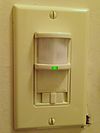
Consumer products
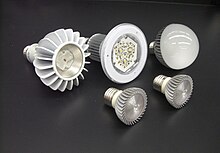
Homeowners implementing ECMs in their residential buildings often start with an energy audit. This is a way homeowners look at what areas of their homes are using, and possibly losing energy. Residential energy auditors are accredited by the Building Performance Institute (BPI)[15] or the Residential Energy Services Network (RESNET).[16][17] Homeowners can hire a professional or do it themselves[18][19] or use a smartphone to help do an audit.[20]
Energy conservation measures are often combined into larger guaranteed Energy Savings Performance Contracts to maximize energy savings while minimizing disruption to building occupants by coordinating renovations.[21] Some ECMs cost less to implement yet return higher energy savings. Traditionally, lighting projects were a good example of "low hanging fruit"[22] that could be used to drive implementation of more substantial upgrades to HVAC systems in large facilities. Smaller buildings might combine window replacement with modern insulation using advanced building foams to improve energy for performance. Energy dashboard projects[23] are a new kind of ECM that relies on the behavioral change of building occupants to save energy. When implemented as part of a program, case studies, such as that for the DC Schools, report energy savings up 30%.[24] Under the right circumstances, open energy dashboards can even be implemented for free[25] to improve upon these savings even more.
Consumers are often poorly informed of the savings of energy-efficient products.[citation needed] A prominent example of this is the energy savings that can be made by replacing an incandescent light bulb with a more modern alternative. When purchasing light bulbs, many consumers opt for cheap incandescent bulbs, failing to take into account their higher energy costs and lower lifespans when compared to modern compact fluorescent and LED bulbs. Although these energy-efficient alternatives have a higher upfront cost, their long lifespan and low energy use can save consumers a considerable amount of money.[26] The price of LED bulbs has also been steadily decreasing in the past five years due to improvements in semiconductor technology. Many LED bulbs on the market qualify for utility rebates that further reduce the price of the purchase to the consumer.[27] Estimates by the U.S. Department of Energy state that widespread adoption of LED lighting over the next 20 years could result in about $265 billion worth of savings in United States energy costs.[28]
The research one must put into conserving energy is often too time-consuming and costly for the average consumer when there are cheaper products and technology available using today's fossil fuels.[29] Some governments and NGOs are attempting to reduce this complexity with Eco-labels that make differences in energy efficiency easy to research while shopping.[30]
To provide the kind of information and support people need to invest money, time and effort in energy conservation, it is important to understand and link to people's topical concerns.
In warm climates where air conditioning is used, any household device that gives off heat will result in a larger load on the cooling system. Items such as stoves, dishwashers, clothes dryers, hot water, and incandescent lighting all add heat to the home. Low-power or insulated versions of these devices give off less heat for the air conditioning to remove. The air conditioning system can also improve efficiency by using a heat sink that is cooler than the standard air heat exchanger, such as geothermal or water.
In cold climates, heating air and water is a major demand for household energy use. Significant energy reductions are possible by using different technologies. Heat pumps are a more efficient alternative to electrical resistance heaters for warming air or water. A variety of efficient clothes dryers are available, and the clothes lines requires no energy- only time. Natural-gas (or bio-gas) condensing boilers and hot-air furnaces increase efficiency over standard hot-flue models. Standard electric boilers can be made to run only at hours of the day when they are needed by means of a time switch.[35] This decreases energy use vastly. In showers, a semi-closed-loop system could be used. New construction implementing heat exchangers can capture heat from wastewater or exhaust air in bathrooms, laundry, and kitchens.
In both warm and cold climate extremes, airtight thermal insulated construction is the largest factor determining the efficiency of a home. Insulation is added to minimize the flow of heat to or from the home, but can be labor-intensive to retrofit to an existing home.
Energy conservation by countries
Asia
Although energy efficiency is expected to play a vital role in cost-effectively cutting energy demand, only a small part of its economic potential is exploited in Asia. Governments have implemented a range of subsidies such as cash grants, cheap credit, tax exemptions, and co-financing with public-sector funds to encourage energy-efficiency initiatives across several sectors. Governments in the Asia-Pacific region have implemented a range of information provision and labeling programs for buildings, appliances, and the transportation and industrial sectors. Information programs can simply provide data, such as fuel-economy labels, or actively seek to encourage behavioral changes, such as Japan's Cool Biz campaign that encourages setting air conditioners at 28-degrees Celsius and allowing employees to dress casually in the summer.[36][37]
China's government has launched a series of policies since 2005 to effectively promote the goal of reducing energy-saving emissions; however, road transportation, the fastest-growing energy-consuming sector in the transportation industry, lacks specific, operational, and systematic energy-saving plans.[5] Road transportation is the highest priority to achieve energy conservation effectively and reduce emissions, particularly since social and economic development has entered the "new norm" period. Generally speaking, the government should make comprehensive plans for conservation and emissions reduction in the road transportation industry within the three dimensions of demand, structure, and technology. For example, encouraging trips using public transportation and new transportation modes such as car-sharing and increasing investment in new energy vehicles in structure reform, etc.[5]
European Union
At the end of 2006, the European Union (EU) pledged to cut its annual consumption of primary energy by 20% by 2020.[38] The EU Energy Efficiency Directive 2012 mandates energy efficiency improvements within the EU.[39]
As part of the EU's SAVE program,[40] aimed at promoting energy efficiency and encouraging energy-saving behavior, the Boiler Efficiency Directive[41] specifies minimum levels of efficiency for boilers using liquid or gaseous fuels.
There is steady progress on energy regulation implementation in Europe, North America, and Asia, with the highest number of building energy standards being adopted and implemented. Moreover, the performance of Europe is highly encouraging concerning energy standard activities. They recorded the highest percentage of mandatory energy standards compared to the other five regions.[42]
In 2050, energy savings in Europe can reach 67% of the 2019 baseline scenario, amounting to a demand of 361 Mtoe in an "energy efficiency first" societal trend scenario. A condition is that there be no rebound effect, for otherwise the savings are 32% only or energy use may even increase by 42% if techno-economic potentials are not realized.[43]
Germany has reduced its
India
The Petroleum Conservation Research Association (PCRA) is an Indian governmental body created in 1978 that engages in promoting energy efficiency and conservation in every walk of life. In the recent past, PCRA has organised mass media campaigns in television, radio, and print media. This is an impact-assessment survey by a third party that revealed that due to these larger campaigns by PCRA, the public's overall awareness level has gone up leading to the saving of fossil fuels worth crores of rupees, besides reducing pollution.
The Bureau of Energy Efficiency is an Indian government organization created in 2001 that is responsible for promoting energy efficiency and conservation.
Protection and Conservation of Natural Resources are done by Community Natural Resources Management (CNRM).
Iran
Japan
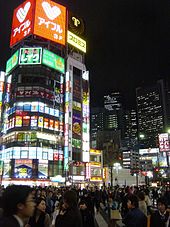
Since the 1973 oil crisis, energy conservation has been an issue in Japan. All oil-based fuel is imported, so domestic sustainable energy is being developed.
The Energy Conservation Center[50] promotes energy efficiency in every aspect of Japan. Public entities are implementing the efficient use of energy for industries and research. It includes projects such as the Top Runner Program.[51] In this project, new appliances are regularly tested on efficiency, and the most efficient ones are made the standard.
Middle East
The Middle East holds 40% of the world's crude oil reserves and 23% of its natural gas reserves.[52] Conservation of domestic fossil fuels is, therefore, a legitimate priority for the Gulf countries, given domestic needs as well as the global market for these products. Energy subsidies are the chief barrier to conservation in the Gulf. Residential electricity prices can be a tenth of U.S. rates.[52] As a result, increased tariff revenues from gas, electricity, and water sales would encourage investment in natural gas exploration and production and generation capacity, helping to alleviate future shortages.
Households in the MENA region are responsible for 53% of energy use in Saudi Arabia and 57% of the UAE's ecological footprint.[52] This is partially due to poorly designed and constructed buildings, mainly under a cheap energy model that has left them without contemporary control technology or even proper insulation and efficient appliances. Building energy consumption can be cut by 20% under a combination of insulation, efficient windows and appliances, shading, reflective roofing, and a host of automated controls that adjust energy use.[52]
Governments could also set minimum energy efficiency and water use standards on importing appliances sold inside their countries, effectively banning the sale of inefficient air conditioners, dishwashers, and washing machines. Administration of the laws would essentially be a function of national customs services. Governments could go further, offering incentives – or mandates – that air conditioners of a certain age be replaced.[52]
Lebanon
In Lebanon and since 2002
Nepal
Until recently, Nepal has been focusing on the exploitation of its huge water resources to produce hydropower. Demand-side management and energy conservation were not in the focus of government action. In 2009, bilateral Development Cooperation between Nepal and the Federal Republic of Germany has agreed upon the joint implementation of the "Nepal Energy Efficiency Programme". The lead executing agencies for the implementation are the Water and Energy Commission Secretariat (WECS). The aim of the program is the promotion of energy efficiency in policymaking, in rural and urban households as well as in the industry.[53]
Due to the lack of a government organization that promotes energy efficiency in the country, the
A study conducted in 2012 found out that Nepalese industries could save 160,000-megawatt hours of electricity and 8,000 terajoules of thermal energy (like diesel, furnace oil, and coal) every year. These savings are equivalent to annual energy cost cut of up to 6.4 Billion Nepalese Rupees.[55][56] As a result of Nepal Economic Forum 2014,[57] an economic reform agenda in the priority sectors was declared focusing on energy conservation among others. In the energy reform agenda, the government of Nepal gave the commitment to introduce incentive packages in the budget of the fiscal year 2015/16 for industries that practices energy efficiency or use efficient technologies (incl. cogeneration).[58]
New Zealand
In New Zealand the Energy Efficiency and Conservation Authority is the Government Agency responsible for promoting energy efficiency and conservation. The Energy Management Association of New Zealand is a membership-based organization representing the New Zealand energy services sector, providing training and accreditation services with the aim of ensuring energy management services are credible and dependable.[59]
Nigeria
In Nigeria, the Lagos State Government is encouraging Lagosians to imbibe an energy conservation culture. In 2013, the Lagos State Electricity Board (LSEB)[60] ran an initiative tagged "Conserve Energy, Save Money" under the Ministry of Energy and Mineral Resources. The initiative is designed to sensitize Lagosians around the theme of energy conservation by influencing their behavior through do-it-yourself tips.[61] In September 2013, Governor Babatunde Raji Fashola of Lagos State and the campaign ambassador, rapper Jude "MI" Abaga[62] participated in the Governor's conference video call[63] on the topic of energy conservation.
In addition to this, during the month of October (the official energy conservation month in the state), LSEB hosted experience centers in malls around Lagos State where members of the public were encouraged to calculate their household energy consumption and discover ways to save money using a consumer-focused energy app.[64] To get Lagosians started on energy conservation, solar lamps and energy-saving bulbs were also handed out.
In Kaduna State, the Kaduna Power Supply Company (KAPSCO) ran a program to replace all light bulbs in Public Offices; fitting energy-saving bulbs in place of incandescent bulbs. KAPSCO is also embarking on an initiative to retrofit all conventional streetlights in the Kaduna Metropolis to LEDs which consume much less energy.
Sri Lanka
Sri Lanka currently consumes fossil fuels, hydro power, wind power, solar power and dendro power for their day to day power generation. The Sri Lanka Sustainable Energy Authority is playing a major role regarding energy management and energy conservation. Today, most industries are requested to reduce their energy consumption by using renewable energy sources and optimizing their energy usage.
Turkey
Turkey aims to decrease by at least 20% the amount of energy consumed per GDP of Turkey by 2023 (energy intensity).[65]
United Kingdom
The Department for Business, Energy and Industrial Strategy is responsible for promoting energy efficiency in the United Kingdom.


